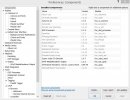Hello,
I have Matrix Element X and it does not play DSD files without rather loud and mostly annoying clicks in between the titles. In Asset UPnP there is an option to play DSF files as WAV, which means it is transcoding from DSD into PCM format. I have been noticing the quality of sound is audibly better when playing FLAC files as WAV (likely because the task of conversion is done on the server and not on the final rendering device, thus keeping it less "busy" - I would not know) but is it to be expected for the quality of sound to drop when transcoding from DSD to WAV in return? I mean, DSD is the best sounding format (when mastered from the closest source, of course), but what can be done when the rendering device just does not handle it as well as was intended (and goes without saying advertised).
I have Matrix Element X and it does not play DSD files without rather loud and mostly annoying clicks in between the titles. In Asset UPnP there is an option to play DSF files as WAV, which means it is transcoding from DSD into PCM format. I have been noticing the quality of sound is audibly better when playing FLAC files as WAV (likely because the task of conversion is done on the server and not on the final rendering device, thus keeping it less "busy" - I would not know) but is it to be expected for the quality of sound to drop when transcoding from DSD to WAV in return? I mean, DSD is the best sounding format (when mastered from the closest source, of course), but what can be done when the rendering device just does not handle it as well as was intended (and goes without saying advertised).

